Our main test involves using a DataColor Spyder Elite 5 Colorimeter to assess a display’s image quality. The device sits on top of the screen while the software generates colour tones and patterns, which it compares against predetermined values to work out how accurate the screen is.
The results show –
- A monitor’s maximum brightness in candelas or cd/m2 at various levels set in the OSD.
- A monitor’s contrast ratio at various brightness levels in the OSD.
- The brightness deviation across the panel.
- The black and white points
- The colour accuracy, expressed as a Delta E ratio, with a result under 3 being fine for normal use, and under 2 being great for colour-accurate design work.
- The exact gamma levels, with a comparison against preset settings in the OSD.
We first run this test with the display in its default, out-of-the-box state, with all settings on default. We then calibrate the screen using the Spyder software and run the test again.
We always test the display subjectively on the Windows desktop, using it for general tasks such as browsing and word processing, and with games as well, even if the display is not intended solely for that purpose. We pay careful attention to any artefacts, ghosting or motion blur, and enable any gaming specific features, such as adaptive-sync settings like G-Sync, using a compatible graphics card in our test PC.
In the case of the Samsung, we performed the primary testing at the native 1,920 x 1,080 resolution in the default Custom preset mode. We also left the monitor at 60Hz (which is not the default – this is 144Hz) because higher refresh rates can affect colour performance. Our test system was equipped with an NVIDIA Quadro K2200. Note that the screenshots below have the wrong Display Name at the bottom. They were not the results of the ASUS ROG SWIFT PG248Q, but for some reason the Spyder system insisted on keeping that monitor name from a previous test.
The uncalibrated results show a commendable gamut, with 100 per cent sRGB coverage and very good 85 per cent Adobe RGB. Samsung has claimed higher figures, but this is above most TN panels, albeit behind top-end IPS panels like the Philips Brilliance 275P4VYKEB. So far, so good.
Brightness uniformity is not the best we've seen, however, with a particular issue down the right-hand side.
But it's also not the worst we have seen in recent months.
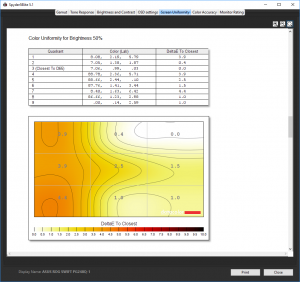
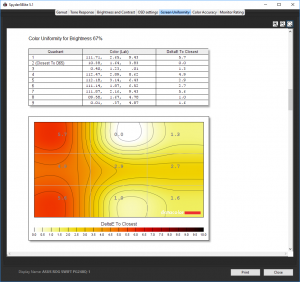
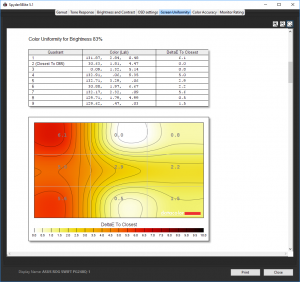
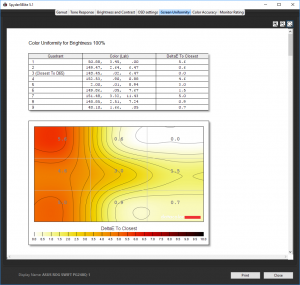
Colour uniformity isn't exceptional either, getting progressively more aberrant on the left-hand side around 83 per cent brightness.
Performance picks up from here onwards. Considering that this screen is only rated at 300cd/m2, the brightness results are pretty much on the money, hitting a little over 315cd/m2 at 100 per cent.
Contrast is quite consistent above 50 per cent brightness and illustrates one of the strengths of VA, being always well over 1000:1, and getting steadily higher as you drop the brightness below that level. However, the most gratifying aspect is how consistent the white point is – spot on 7200K across the brightness levels.
The plethora of OSD settings show mostly subtle differences. The default settings for the Custom adjustments are very similar to the High-Brightness preset, with maximum brightness of 315cd/m2 and just a subtle difference in contrast, plus 7200K white point. The FPS mode drops brightness and contrast down a little, but takes colours to a cooler 8200K.
The RTS mode is almost identical, with just a slightly higher contrast and lower black point. The RPG mode is very similar to High-Brightness, as is AOS, with the latter just taking contrast down a notch. The sRGB and Cinema modes are indistinguishable with these tests too.
It's quite strange that the presets provided are all so similar in end result, although they also include other settings that aren't picked up by the Spyder tests. Interestingly, the black point is nearly identical across all the presets.
The Mode 1 gamma setting is equivalent to 2.1, whilst Mode 2 is 1.9 and Mode 3 very close to 2.2. So there isn't a wide range of gamma values available.
The factory calibration has clearly worked a treat, with an excellent 1.08. We have only seen a couple of results better than this, in particular the ASUS ROG SWIFT PG248Q (when calibrated), and Dell's UltraSharp 24 InfinityEdge U2417H was close too. But out of the box this is an amazing result.
Next we calibrated the screen using the Spyder to see if this could improve matters.
The colour gamut is actually slightly worse, with 100 per cent of sRGB visible, and 84 per cent of AdobeRGB – but nothing to get worried about.
Gamma Mode 1 has now dropped a little to 2.0.
It was never going to be easy to improve on the brilliant colour accuracy of this screen, but we managed it… by 0.01! This was hardly worth the effort. You don't really need to calibrate this monitor, since Samsung did the hard work for you at the factory.
Overall, image quality is really excellent, a close match to the best IPS and PLS panels. There is a slight concern over brightness and colour uniformity, but only a slight one.
Otherwise, the C24FG70 lives up to Samsung's billing as a gaming monitor that doesn't sacrifice quality for gaming responsiveness, as is very often the case with TN panels. We put the screen through a variety of subjective gaming and motion tests and found the experience comparable to or better than a 1ms TN gaming panel. The anti-motion blur technology appears to work as claimed.
 KitGuru KitGuru.net – Tech News | Hardware News | Hardware Reviews | IOS | Mobile | Gaming | Graphics Cards
KitGuru KitGuru.net – Tech News | Hardware News | Hardware Reviews | IOS | Mobile | Gaming | Graphics Cards
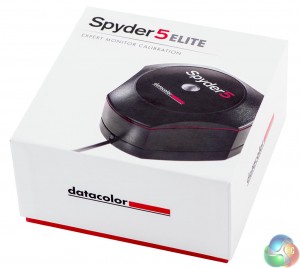
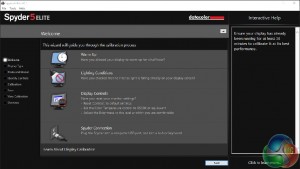
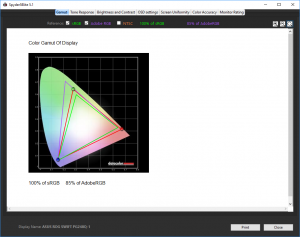
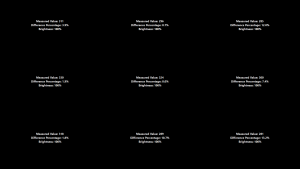
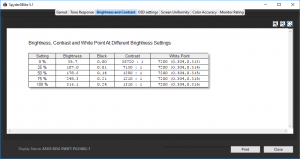
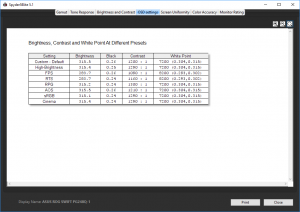
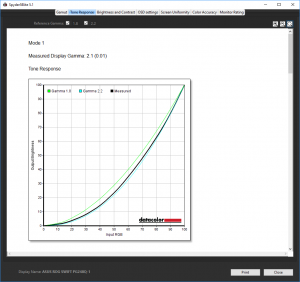
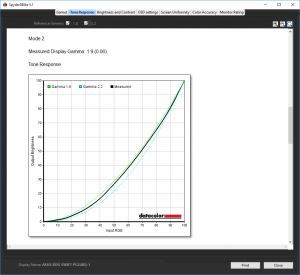
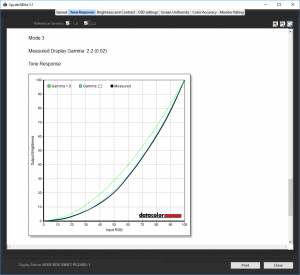
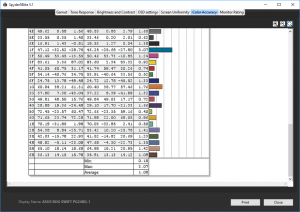
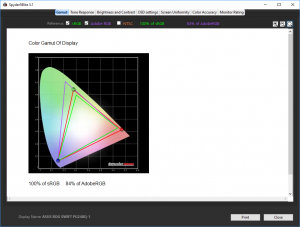
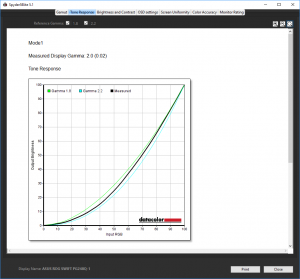
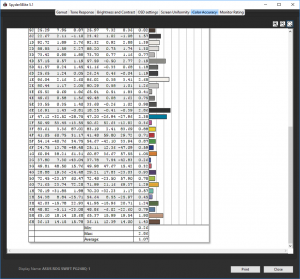

A nice monitor for those who wish to game at 1920 x 1080 but more and more gamers are moving to 2K and 4K gaming.
if i want to buying a monitor i prefer a 2k , because games look great in that monitor , thanks alot
I moved to 1440p and as a high refresh rate gamer, immediately wish I hadn’t due to being unable to keep up the framerate with a 1080 even.
I’ll be purchasing this monitor if I can due to the vast colour gamut advantage it has at 125% of sRGB and the fact the contrast ratio is immensely better than any other panel besides OLED.
1080P is 2K aswell
Google is paying 97$ per hour! Work for few hours and have longer with friends & family! !mj328d:
On tuesday I got a great new Land Rover Range Rover from having earned $8752 this last four weeks.. Its the most-financialy rewarding I’ve had.. It sounds unbelievable but you wont forgive yourself if you don’t check it
!mj328d:
➽➽
➽➽;➽➽ http://GoogleFinancialJobsCash328MediaInfoGetPay$97Hour… ★★✫★★✫★★✫★★✫★★✫★★✫★★✫★★✫★★✫★★✫★★✫★★✫★★✫★★✫★★✫★★✫★★✫★★::::::!mj328d:….,…..
there is not much difference at all between 1080p and 1440p except it eats a lot of FPS. You can see as much on 1080p as you can on 1440p. Tho you will have to drop those eye candy options for 1440p if you want 100+ fps. That’s why you’re getting 1440p 144hz right?
Nah… That ain’t true. 1440p and 4k are still pretty much useless. You can’t even game proper even on gtx 1080. In order to playo n those resolutions at a decent frame of 100 you need to wait perhaps next generation of GPUs even then they won’t be able to run it on 1440p as much as the graphical fidelity will always increase as well. So 1080p is going to be the main resolution for years to come mate. 🙂
But what were the calibrated color settings? I’ve been trying to find some color settings for this but can’t find anything.
Same issue. Like why not post what you enhanced.